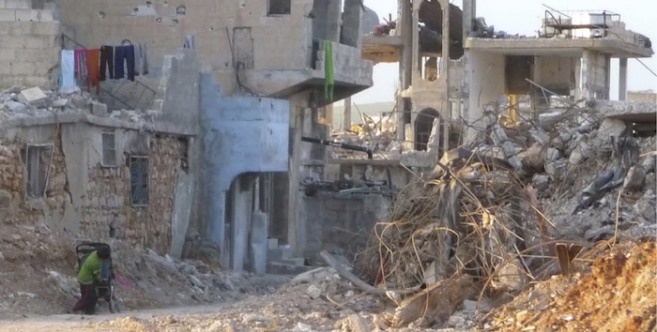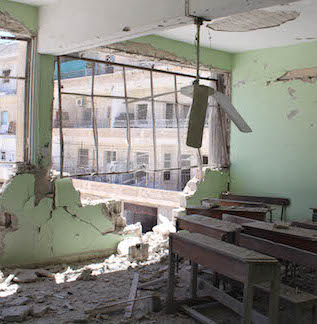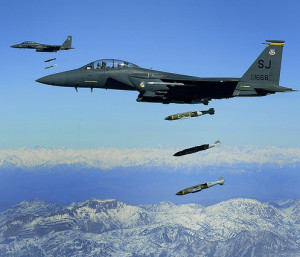Global recognition of the humanitarian harm caused by the use of explosive weapons in populated areas, and calls on states and conflict parties to curb this, are growing. Below is a round up of publications from INEW members and other organisations released in recent months, looking at harm to civilians in Syria, Yemen, Gaza, Sudan, Afghanistan and across the world. More than 40 countries have recognised the bombing and bombardment of towns and cities as a specific problem, with 25 calling for action to address it – see INEW’s latest briefing paper on this, and our full archive of statements.

Devastation in the city of Kobani, Syria (Handicap International)
Handicap International: Syria’s time bomb of explosive weapons contamination puts 2 million children at risk
In ‘The use of explosive weapons in Syria: A time bomb in the making‘, released in May 2015, Handicap International revealed that weapons contamination in Syria is putting 5.1 million people at risk, including 2 million children. The report calls on conflict parties to immediately end the use of explosive weapons in populated areas, and calls on the international community to urgently respond in order to address the harmful effects of these weapons on civilians. Read more
Handicap International: devastation and continuing danger from explosive weapons in Kobani
In a May 2015 brief based on a research visit to the city, ‘Kobani: A city of rubble and unexploded devices‘, Handicap International documented the catastrophic impact that the use of explosive weapons in populated areas has had in the Syrian city of Kobani. As well as death, injury and the destruction of homes and vital infrastructure, civilians returning to Kobani to rebuild their lives face immense danger from an alarming level of unexploded ordnance, and the aftermath of shocking tactics such as the booby-trapping of corpses. Read more
Amnesty International: Syria conflict parties must stop using imprecise explosive weapons in civilian population centres
In its May 2015 report ‘Death everywhere – war crimes and human rights abuses in Aleppo, Syria‘ Amnesty International detailed the terrible toll on civilians from bombing and bombardment in Syria, including the use of barrels bombs, and called on all conflict parties to end the use of imprecise explosive weapons in populated areas. Amnesty International also released documentation in May on the harm caused by anti-aircraft weapons and airstrikes on weapons depots in Yemen. Read more

A destroyed school in Syria (Failing Syria)
Human Rights Watch: Bombing campaign in Sudan takes a heavy toll on children
In April 2015 HRW visited rebel-held villages in the Nuba Mountains area of South Kordofan, Sudan, which have been hit frequently by air-dropped bombs and shelling over the past year. ‘Sudan: Bombing campaign’s heavy toll on children‘ documents the severe impact of this use of explosive weapons in populated areas, particularly on children, including death, injury, the destruction of infrastructure such as health facilities and the impact on children’s education. Read more
UN Office for the Coordination of Humanitarian Affairs (OCHA) fact sheet on the global problem of explosive weapons
A two page brief on ‘Protecting civilians from the use of explosive weapons in populated areas‘, produced by the UN OCHA policy section, was released in April 2015. It sets out the humanitarian problem of explosive weapons in populated areas, from the immediate impact of deaths and injuries to the long-term harm caused by the destruction of infrastructure. It also highlights UN action to address this, including the UN Secretary-General’s call on all conflict parties to refrain from using explosive weapons with wide area effects in populated areas. Read more
Action on Armed Violence (AOAV): Israel’s artillery policies and risk to civilians in Gaza
Artillery is often referred to as a ‘statistical weapon’ by Israeli military experts, and its use in and near populated areas puts civilians at grave risk of death and injury. In its report ‘Under fire: Israel’s artillery policies scrutinised‘ AOAV analyses how the loosening of rules on artillery practice in 2005, including ‘safety distances’ from civilian objects, has meant that civilians are now at more risk from shelling by Israeli forces than previously. In May 2015 Israeli NGO Breaking the Silence released ‘This is how we fought in Gaza‘. This collection of Israeli soldiers’ testimonies on 2014’s Operation Protective Edge contains vivid descriptions of the short- and long-term harm caused by the heavy use of explosive weapons in urban areas, and the context of the use of these tactics in Gaza. Read more

Airstrike in Afghanistan, 2009 (US Air Force)
Action on Armed Violence: tactical directives and reducing civilian casualties in Afghanistan
Civilian deaths from aerial bombing in Afghanistan fell by 81% between 2008 and 2014. In its report ‘Air power in Afghanistan: How NATO changed the rules, 2008-2014‘, AOAV analyses three NATO tactical directives introduced to restrict the use of aerial explosive weapons in populated areas during this period. Collectively, the tightening of these rules by NATO provides a clear example of how changes in military operations can protect civilians by restricting the use of explosive weapons in populated areas, and set policy that goes beyond existing laws without jeopardising key military objectives. Read more
Amnesty International: Restricting use of explosive weapons in populated areas would protect civilians
In their annual report for 2014/15, ‘The State of the World’s Human Rights’, Amnesty International highlighted the need to address explosive weapons as a civilian protection issue, stating: “One step that could be taken to protect civilians in conflict would be to further restrict the use of explosive weapons in populated areas. This would have saved many lives in Ukraine”. The need to curb explosive weapons use was also highlighted in a video accompanying the report. Read more
Read more
Explore INEW’s archive of resources on explosive weapons
Read about latest developments in our news section
Acknowledging the harm: full archive of state, UN and ICRC acknowledgement of the issue
